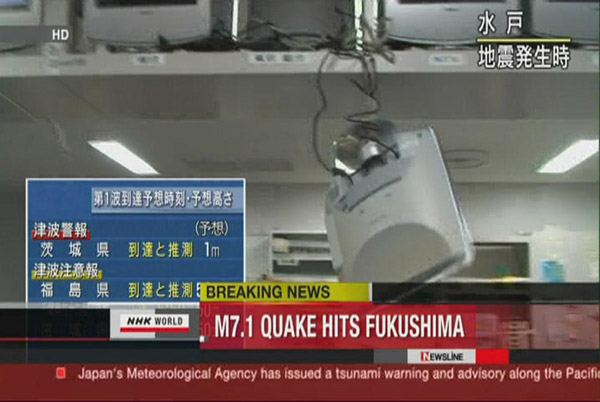Asia
Japan rattled by aftershock on quake anniversary
Updated: 2011-04-11 20:04
(Agencies)
|
 A television screen swings after falling off a shelf in an office during an earthquake in Mito City, Ibaraki Prefecture, in this still image taken from NHK footage April 11, 2011. A magnitude 7.1 tremor shook buildings in Tokyo and a wide swathe of eastern Japan on Monday evening, triggering a small tsunami alert. [Photo/Agencies] |
TOKYO – Japan on Monday expanded the evacuation zone around its crippled nuclear plant because of high levels of accumulated radiation, as a strong aftershock rattled the area one month after a quake and tsunami sparked the worst nuclear crisis since Chernobyl.
A magnitude 7.1 tremor shook buildings in Tokyo and a wide swathe of eastern Japan on Monday evening, triggering a small tsunami alert. NHK state television said it caused the off-site power supply for two damaged reactors to shut down.
Tokyo Electric Power Co (TEPCO), which operates the plant, said workers had stopped pouring cooling water on reactors No. 1, No. 2 and No. 3 at Fukushima.
Chief Cabinet Secretary Yukio Edano said villages and towns outside the 20 km (12 mile) evacuation zone that have had more accumulated radiation would be evacuated. Children, pregnant women, and hospitalized patients should stay out of some areas 20-30 km from the Fukushima nuclear complex, he added.
The decision to widen the evacuation band around the Fukushima plant was "based on data analysis of accumulated radiation exposure information", Edano told a news conference.
"These new evacuation plans are meant to ensure safety against risks of living there for half a year or one year," he said. There was no need to evacuate immediately, he added.
Japan had resisted extending the zone despite international concerns over radiation spreading from the six damaged reactors at Fukushima, which engineers are still struggling to bring under control after they were wrecked by the 15-meter tsunami.
Residents of one village, Iitate, which is 40 km from the Fukushima Daiichi plant, have been told to prepare for evacuation because of prolonged exposure to radiation, a local official told Reuters by phone. It has a population of 5,000.
The International Atomic Energy Agency has urged Japan to extend the zone and some countries, including the United States, have advised their citizens to stay 80 km away from the plant.
TEPCO President Masataka Shimizu visited the area on Monday for the first time since the March 11 disaster. He had all but vanished from public view apart from a brief apology shortly after the crisis began and has spent some of the time since in hospital.
"I would like to deeply apologize again for causing physical and psychological hardships to people of Fukushima prefecture and near the nuclear plant," said a grim-faced Shimizu.
Dressed in a blue work jacket, he bowed his head for a moment of silence with other TEPCO officials at 2:46 pm (0546 GMT), exactly a month after the earthquake hit.
Fukushima Governor Yuhei Sato refused to meet Shimizu during his visit, but the TEPCO boss left a business card at the government office.
Sato has criticized the evacuation policy, saying residents in a 20-30 km radius were initially told to stay indoors and then advised to evacuate voluntarily.
Radioactive water
Engineers at the damaged Daiichi plant north of Tokyo said they were no closer to restoring the plant's cooling system which is critical if overheated fuel rods are to be cooled and the six reactors brought under control.
In a desperate move to cool highly radioactive fuel rods, operator Tokyo Electric Power Co (TEPCO) has pumped water onto reactors, some of which have experienced partial meltdown.
But the strategy has hindered moves to restore the plant's internal cooling system, critical to end the crisis, as engineers have had to focus how to store 60,000 tons of contaminated water.
Engineers have been forced to pump low-level radioactive water, left by the tsunami, back into the sea in order to free up storage capacity for highly contaminated water from reactors.
E-paper

Green light
F1 sponsors expect lucrative returns from Shanghai pit stop
Buying into the romance
Born to fly
Light of hope
Specials

Share your China stories!
Foreign readers are invited to share your China stories.

No more Mr. Bad Guy
Italian actor plans to smash ‘foreign devil’ myth and become the first white kungfu star made in China.

Art auctions
China accounted for 33% of global fine art sales.




